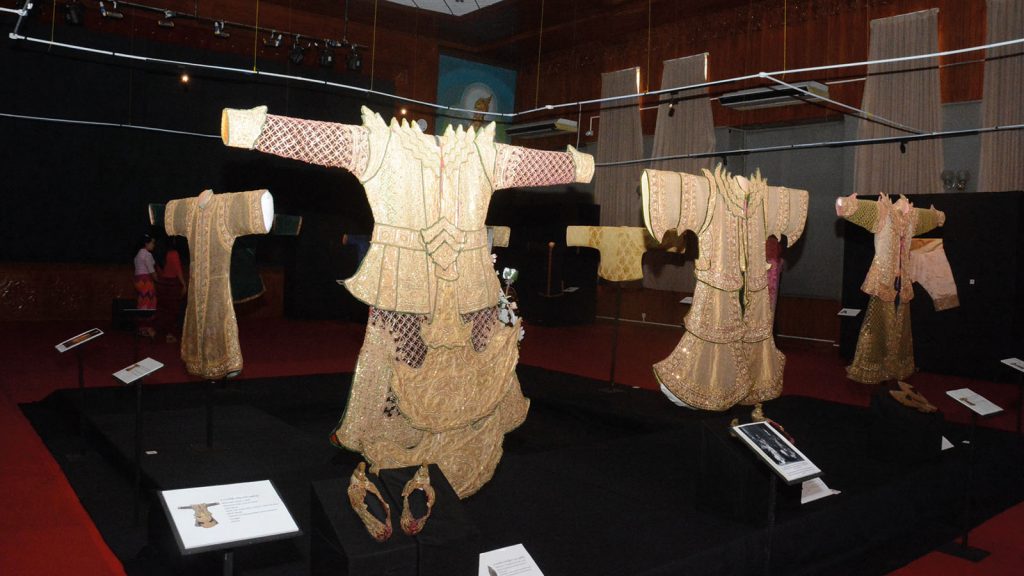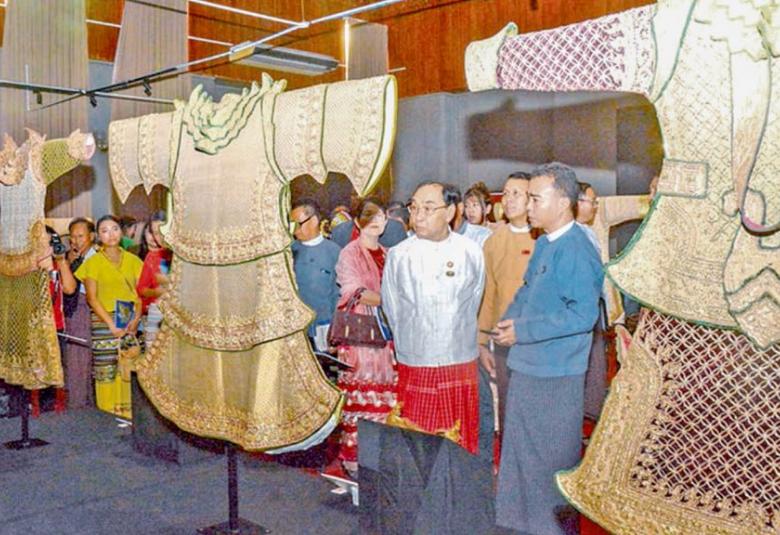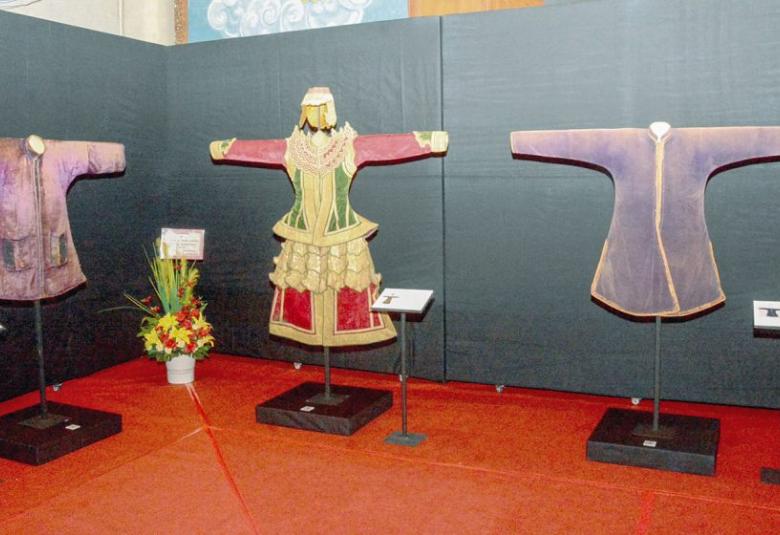As per the saying “Nine Saophas and nine reigns of Shan” the ethnic Shan nationals in Myanmar established nine Mao Kingdoms. They were Mogaung, Mohnyin, Thaungthut, Mongmit, Mongnai, Hsenwi, Mongpe, Nyaungshwe and Hsipaw.
According to “History of the Shan State – From its origins to 1962” by Sai Aung Tun the years from 1287 to 1531 are recognized as the period of Shan kings in Upper Myanmar. This period witnessed the successful establishment of the three historically famous cities of Pinya, Sagaing and Inwa (Ava) by the Shan kings. As the successive Shan kings ruled in these cities, they let their sons and brothers rule their regions of origin in Shan as Saophas which was eventually called Sawbwas in Myanmar language. Shan Saophas uses royal objects like white umbrellas, headdresses and foot wears used by the Myanmar kings.
Shan Saophas lived in Haw (palace) and after they faded from history, their Haw and royal objects remains as cultural heritages. Nyaungshwe museum is one of the many museums in Shan State that had maintained and displayed these cultural heritages.
Nyaungshwe and Saopha Haw
Nyaungshwe in Shan State, Taunggyi District is 602 km. from Yangon and 30 km. from Taunggyi and was a town visited by visitors who came to Inle Lake. On the east of the town are Taunggyi and Hsihseng while to the west lies Kalaw and Pinlaung. It is connected to Pekhon Township to the north and to Taunggyi Township to the south.
Nyaungshwe with an area of 561 square miles is at an elevation of 2,950 ft. Nyaungshwe Township was formed with 8 wards and 35 village tracts with 445 villages. According to 2017 Census the township had a total population of 171,459 of which 69 per cent were Intha while Pa-O made up 13.5 per cent.
Nyaungshwe was established by Saopha Si Sai Pha in 1359. In Shan language it was called Yawnghwe meaning a plateau between two mountains.
Nyaungshwe had Phaung Daw Oo Pagoda, Alodawpauk Pagoda and Shwe Intane Pagoda in Inle Lake and Yadana Mann Aung Pagoda in Nyaungshwe town as well as 1,013 pagodas and stupas. A cultural museum (Nyaung Shwe Haw) situated in Nandawun is also a historical building in Nyaungshwe.
The present Nyaungshwe Haw was built by a Shan Saopha Sir Saw Maung in 1913. The construction took 10 years and cost some 300,000 Kyats (a couple of billion Kyats in today’s money). Maukmai Saopha Sao Kham Hlaing drew the design of the Haw combining the Mandalay Palace design and traditional Haw of Shan Saophas. The construction was led by carpenter U Ngo @ U Htun Aung and Shan artisans.
After the first Nyaungshwe Haw was destroyed in Nyaungshwe town fire of 1908 the present Haw was built with 206 pillars. It was a rectangular structure measuring 200 ft. from east to west and 194 ft. from north to south and faces toward the east. The two-story Haw with seven tier roof contains three main halls. The hall to pay homage to the Saophas was where the Saophas received his subjects paying homage to him twice a year and it had a throne. When the Buddha images from Inle Phaung Daw Oo Pagoda were in town, the images were placed on this throne where the people came to worship it.
The outer hall is where the Saopha and his ministers discussed matters relating to the people. The inner hall is where the Saopha, his family, trusted ministers and aides discussed family, royal and religious matters. Soaphas of Shan State conducted preliminary discussion for Panglong Agreement matters on 8 February 1947 in this inner hall.
In addition to these three halls, Nyaungshwe Haw had a building (South Dawei Building) on the south for Saopha’s mother and mahadevi (Saopha’s wife), a building (North Dawei Building) for the Saopha and sons.
There’s a 10 ft. square rectangular room with iron bars in the middle of the ground floor of the Haw that was considered as a safe room. It was used as Japanese military police Kempeitai office room during the Japanese occupation in Second World War.
National Museum and Saopha costumes
There were more than 55,000 museums all over the world and National Museums are where a country’s cultural and historical heritages were displayed. Myanmar had two national level museums in Yangon and Nay Pyi Taw.
These national museums occasionally conducted paper reading sessions and special exhibitions that raise interest as well as drawing visitors. An exhibition at Yangon National Museum from 9 to 18 June this year of Shan Saophas’ rare costumes was one such exhibition. 30 out of 138 Shan Saophas’ costumes stored in Nyaungshwe Cultural Museum were put on display at that exhibition.
Saopha costumes from Nyaungshwe Haw
On August 2016 Shan State government under the guidance of the Union Minister for Hotels and Tourism proposed to Ministry of Religious Affairs and Culture to send 138 costumes of Shan Saophas stored in Nyaungshwe Cultural Museum to France for maintenance and restoration so that it can be displayed properly and for long.
After inspection by Yangon National Museum a decision was made to conduct the majority of the maintenance and restoration works in Myanmar.
A preliminary visit to Nyaungshwe Cultural Museum was conducted in September 2016. On 18 January 2018 Yangon National Museum Director Daw Nang Laung Ngin and party obtained the guidelines and instructions of the local Sayadaws about the maintenance and restoration work. Afterwards they also met and explained to the Haw maintenance group and locals about the maintenance and restoration work processes. Some costumes were then sent to Yangon National Museum laboratory on 2 March 2018 for maintenance and restoration works.
After the maintenance and restoration works were completed the costumes were sent back to Nyaungshwe Cultural Museum. The remaining costumes were then sent to Yangon National Museum as second batch and maintenance and restoration works were conducted.
Of the costumes sent back to Nyaungshwe Cultural Museum, all could not be put on display due to limitation of display space. Textile Stores were constructed to systematically store the costumes that were not displayed and arrangements were made to put the costumes on display alternatively.
After the second batch of costumes were maintained and restored some were sent back to Nyaungshwe Cultural Museum. From this second batch, 30 costumes were exhibited to the public in Yangon National Museum.
Exhibition of rare costumes
The rare costumes exhibited were not only of the Shan Saophas but also of their Mahadevis, Crown Prince, chief ministers, mayors, military commanders and bodyguards. Not only dresses but headdresses, shoes, belts and trousers were also exhibited.
At the opening ceremony of the exhibition sponsored by the Department of Archaeology, National Museum and Library (DANML) of the Ministry of Religious Affairs and Culture, Union Minister for Ethnic Affairs Nai Thet Lwin said, “Costumes worn by and items used by Shan chieftains of various regions throughout the past successive periods can be viewed by the public, especially the youth and middle-aged people at the exhibition.
The civilization of a race can be studied through their costumes, style of dress, literature and culture. This kind of exhibition will enhance the spirit of an ethnic race to cherish its culture and traditions. Holding of this exhibition at a museum, at a place where Shan people are the majority will attract more tourists.”
Also speaking on the occasion, Chief Minister of Yangon Region U Phyo Min Thein said, “The exhibition enhances the image of the Myanmar races.” He suggested the conservation and display of the cultures and traditions of other ethnic races too. As all the national races are living in amity in the Union, they all should join hands for its perpetuation, he said, and added that all the citizens of the country have the duty to preserve and protect the ethnic cultures and traditions. “At this exhibition, Shan traditions costumes preserved for over 100 years are put on display, and it is a noble tasks,” he said.
Deputy Minister for Religious Affairs and Culture U Kyi Min said, “The attires were sent to France for keeping them under advanced preservation techniques for today’s people to study them. The Department of Archaeology, National Museum and Library has been checking and preserving the attires of Shan chieftains displayed at the Nyaungshwe Culture Museum since Shan State Government requested help from the Ministry of Religious Affairs and Culture in 2016. So the ministry and the state government allotted the budget for the work.”
Director-General of DANML U Kyaw Oo Lwin explained the purpose of the exhibition and Director Daw Nang Laung Ngin the preservation work.
The exhibition reportedly drew thousands of visitors both locals and foreigners and was said to be the best-attended the National Museum has put on.
Maintenance of the costumes
Maintaining of cultural relics consists of many ways including maintaining it as it was produced, providing remedial services to restore it and prevention from damages. Due to the historical, artistic, cultural, social, religious and personal values the costumes from Nyaungshwe Cultural Museum were being maintained and preserved. In late 19th century preservation techniques of clothes develop. Restorers, artefact collectors and dealers started maintaining and restoring clothes to original splendours. These techniques were being used to maintain and restore the invaluable costumes from Nyaungshwe Cultural Museum.
These costumes are now put on display in Nyaungshwe Cultural Museum. Translated by Handytips





